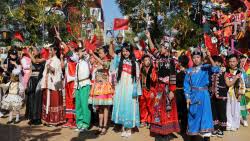Forging a strong sense of community for the Chinese nation through culture and civilization

President Xi Jinping, also general secretary of the Central Committee of the Communist Party of China (CPC), paid an inspection tour to Qinghai, a northwestern province where multiple ethnic groups including Han Chinese and other ethnic minority groups live together. Particularly in his inspection of a middle school, President Xi stressed the significance of education in forging a strong sense of community for the Chinese nation. Though the idea and related policies have been initiated and coined mainly in the field of ethnic affairs, it could be argued that now it’s time for the entire Chinese nation to pay attention to this point.
Nationality is the identity of the people, and the people are the main elements that constitute a nation. The community of the Chinese nation is a pluralistic complex, a historical community and a realistic community, a community of interests and an emotional community, a political community and a cultural community. As a cultural community, the Chinese nation relies on the individual’s identification with the cultural symbols of the Chinese nation. Cultural symbols are the carriers of Chinese culture and the psychological ties that connect individuals with the community of the Chinese nation, which can not only enhance the vitality of Chinese culture and promote the spread of Chinese culture but also unite the strength of Chinese people at home and abroad to promote the great rejuvenation of the Chinese nation.

What is “China”? From the perspective of time, China is a civilization community that runs throughout history; while from the perspective of space, China is a multicultural complex of multiple regimes that existed in different periods. In this complex system, multiple cultures and regimes are not separated but intertwined and influenced by each other. As a result, China is a complex system of diverse cultures and multiple forces.
A history of China is a history of the integration of various ethnic groups into a pluralistic and integrated Chinese nation, and a history of all ethnic groups jointly creating, developing and consolidating a unified great motherland. Ancient China was not a country defined by the modern concept of nation-state, which has the characteristics of “clear center and blurred edges,” but a polity defined by civilization, and the main line of Chinese civilization has never been interrupted from ancient times to the present time.

In the process of development, Chinese civilization continues to learn and influence its surroundings, and this open and dynamic development has brought hope for the future and sustainability of Chinese civilization and even world civilization.
President Xi once pointed out that “culture is the soul of a country and a nation.” China’s western region has a long history and is rich in cultural resources, and only by properly protecting and making good use of it could we fully bring out its tremendous potential and transform it into a majestic force for promoting the development of both the western region and the entire nation.
What is more, the long-term tradition of great unification of Chinese civilization has formed an integratedness of pluralism with unity and concentration. Chinese civilization contains many cultural units, and different regions and ethnic groups have jointly shaped the basic pattern of Chinese civilization in the long-term integration and symbiosis, forming a political civilization community with rich internal elements and distinctive overall characteristics. It is precisely the civilizational goal and political pursuit of Chinese civilization that support the cohesion of many cultural units.
The building process of a unified multi-ethnicity nation under the leadership of the CPC inherited the vast territory of ancient China, covered the cultural units within the Chinese nation, and activated the civilizational pursuit of Chinese civilization. Even in the early days of the People’s Republic of China (PRC), under the leadership of the CPC, the Chinese state did not simply follow or copy the federal system or the confederation system that had been practiced by other countries with vast territories and multiple ethnicities, rather it established a unitary state pattern, and implemented the system of regional ethnic autonomy, which is aimed at conforming to the general trend of the development of the Chinese nation of inward cohesion and pluralism, and inherited the tradition of Chinese cultural unification, maintained cultural subjectivity, and formed a closer and stronger community of the Chinese nation.
Generally speaking, for the building of the modern nation-state, emotion is one essential driving force, while rationality is the other. If the two could overlap and reinforce each other, it would be a perfect situation. But it doesn’t always work like that. Theoretically, a person’s cultural patriotism or cultural nationalism can remain unchanged anywhere on the planet; but economic interests, lifestyle choices, and even political preferences might alter depending on where that person lives. Therefore, the strong national cohesion or internal identity of the modern state requires the combination of traditional emotional cohesion and modern rational national cohesion. This is where forging a strong sense of community for the Chinese nation could play a significant role in the future. While the emotional foundation remains strong and rational judgment is strengthened due to successful modernization, it would be more conducive to maintaining a strong national cohesion mechanism.





